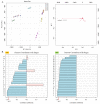Volatiles Accumulation during Young Pomelo (Citrus maxima (Burm.) Merr.) Fruits Development
- PMID: 35628476
- PMCID: PMC9144960
- DOI: 10.3390/ijms23105665
Volatiles Accumulation during Young Pomelo (Citrus maxima (Burm.) Merr.) Fruits Development
Abstract
As widely planted fruits with high nutritional and medical values, pomelos are managed systematically to achieve the largest economic benefits. But the annual shedding of young pomelos, which could be applied as feedstocks for essential oil extraction with their abundant volatiles, leads to a waste of source. The present study selected two commonly planted pomelo (Citrus maxima (Burm.) Merr.) varieties in Southern China, to investigate the volatile profiles during young pomelo fruits development. Combing transcriptomic analysis, this study aimed at identifying the prominent volatile components in young pomelo fruits in order to preferably extract profitable volatiles, as well, increasing the knowledge concerning regulatory roles of transcription factors (TFs) on volatiles accumulation in young pomelos. Totally 29 volatiles were identified, including 14 monoterpenoids and 13 sesquiterpenoids. Diprene was the principal component with the highest amount. Volatiles were generally decreased during fruits development but preferable stages were figured out for volatile collections. 12 and 17 TFs were related to developing time while ERF003 and MYC2 were highly correlated to monoterpenoids. These findings put forward the comprehensive usages of young pomelos and enriched the regulatory roles of TFs on both fruit development and volatiles metabolism.
Keywords: fruit ripening; transcription factors; transcriptomic; volatiles; young pomelos.
Conflict of interest statement
The authors declare no conflict of interest.
Figures





References
-
- Huang S., Dong T., Xiong B., Qiu X., Sun G., Liao L., Fan N., Wang X., Deng H., He S., et al. Variation in the content and composition of limonoids in fruits of four pomelo varieties during fruit development: The natural debittering process in pomelo fruits. J. Food Compos. Anal. 2021;100:103928. doi: 10.1016/j.jfca.2021.103928. - DOI
-
- Wei Q., Liu G., Zhang C., Sun J., Zhang Y. Identification of characteristic volatile compounds and prediction of fermentation degree of pomelo wine using partial least squares regression. LWT. 2022;154:112830. doi: 10.1016/j.lwt.2021.112830. - DOI
-
- Tocmo R., Pena-Fronteras J., Calumba K.F., Mendoza M., Johnson J.J. Valorization of pomelo (Citrus grandis Osbeck) peel: A review of current utilization, phytochemistry, bioactivities, and mechanisms of action. Compr. Rev. Food Sci. Food Saf. 2020;19:1969–2012. doi: 10.1111/1541-4337.12561. - DOI - PubMed
MeSH terms
Substances
Grants and funding
LinkOut - more resources
Full Text Sources
Research Materials

